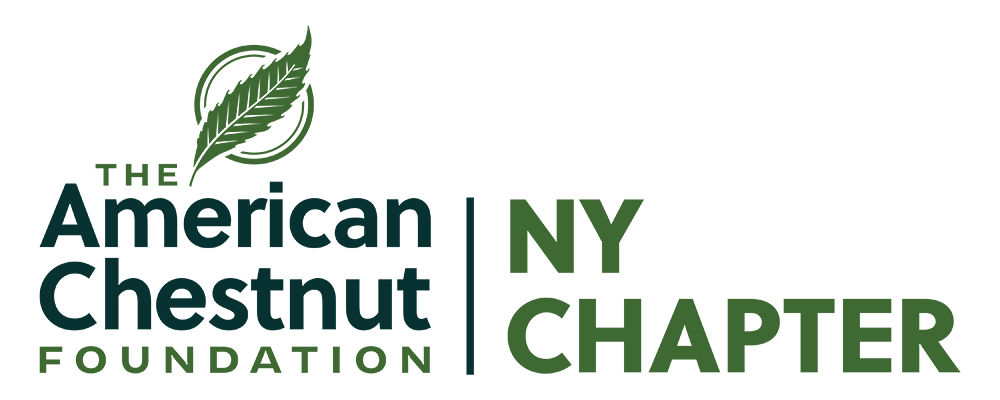
Contact us at gro.fcat@retpahCYN
About Us
Welcome to the New York Chapter of The American Chestnut Foundation! We are dedicated to restoring the American chestnut in New York State.

How is TACF Restoring the American Chestnut?
TACF engages in a multi-pronged effort to create a disease-resistant American chestnut, including traditional breeding techniques and genetic modification.
The majority of TACF staff and volunteers are involved in an advanced breeding approach called Recurrent Genomic Selection (RGS) that uses genetic testing to maximize breeding selections. Sometimes referred to as “Best by Best”, this approach is expected to significantly increase resistance to Phytophthora root rot and chestnut blight within two breeding generations, while maintaining American chestnut form and function. In addition, efforts are made to conserve the range-wide genetic diversity of this growing population of trees for use in future breeding.
TACF is also working with a variety of scientific partners to develop transgenic (introducing genes from other plant species) and cisgenic (introducing genes from other chestnut species of the same genus) methods to increase blight resisitance, as well as other biotech methods such as RNAi (RNA interference) to impede growth of the blight fungus.
Fresh Leadership for the New York Chapter
The Executive Committee of The American Chestnut Foundation’s (TACF) Board of Directors voted in May 2025 to establish a newly restructured, unincorporated New York (NY) Chapter. We warmly welcome a dynamic new leadership team: President Dazzle Ekblad, Treasurer Kurt Dirr, and Outreach Coordinator Lia Heintjes (bios below). “It’s exciting to think about the future of the American chestnut,” said Ekblad. “My first steps as Chapter president are to listen and learn. I look forward to connecting with our New York members and hearing what drives their passion for this extraordinary tree.” Read more…
NY Chapter Board
Dazzle Ekblad, President
Dazzle Ekblad has always loved the company of trees. As you might guess from her name, Dazzle was raised on a hippie commune in northern Minnesota with towering white pines and graceful birch trees. Her awareness of the potential and power of American chestnut trees began when she was studying agroecology at Prescott College and read Tree Crops: A Permanent Agriculture by J. Russell Smith. Dazzle went on to earn her master’s in natural resources policy from SUNY College of Environmental Science and Forestry, as well as a master’s in public administration from Syracuse University. Since 2014, her focus has been on supporting and expanding the New York State Climate Smart Communities Program. In 2022, Dazzle received a Climate Champion Award from the New York Upstate Board of the US Green Building Council.
Kurt Dirr, Treasurer
Kurt Dirr graduated from SUNY College of Environmental Science and Forestry with a bachelor’s degree in environmental resources engineering and a minor in water resources. From there Kurt worked as a design consultant for civil, drinking water, and wastewater design and construction projects throughout the northeast United States addressing treatment, storage, and conveyance issues. Currently, Kurt is working in a role which blends his interest in protecting the environment and improving public infrastructure through civil engineering improvement projects for public boat launches throughout New York State.
Lia Heintjes, Outreach Coordinator
Lia Heintjes first became curious about the American chestnut as an undergraduate student while completing her bachelor’s in biotechnology at SUNY College of Environmental Science and Forestry. The multi-faceted approach to its restoration sparked her interest; what other tree species is so beloved as to mobilize numerous communities to action? After graduating, Lia pivoted from lab work towards the outdoors, working as a green roofer building rooftop gardens, and then as an urban forester with New York City Parks. She cares deeply about the fate of the planet and would someday love to witness native wildlife reconnecting with an American chestnut she helped restore.
Contact
TACF NY Chapter
Contact us at gro.fcat@retpahCYN
Science
For information about growing American chestnuts or American chestnut research in NY, please contact TACF’s North Central Regional Science Coordinator, Lake Graboski, at gro.fcat@iksobarG.ekaL.
Former NY Chapter
The former NY Chapter is now named American Chestnut Restoration, Inc. For information about this organization, please contact Allen Nichols at moc.liamg@57.slohcinkjaf.
To learn more about this transition, read the recent news post Changes to TACF’s NY Chapter.
Follow Us on Social
New York Chapter Menu
Latest News
No Results Found
The page you requested could not be found. Try refining your search, or use the navigation above to locate the post.


